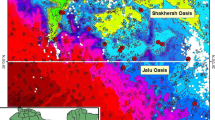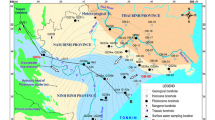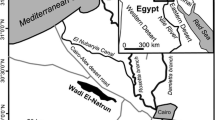Abstract
Al-Atraf is one of the water well fields of Kuwait supplying Kuwait City with the brackish groundwater obtained from the Kuwait Group aquifer of Miocene–Pleistocene age. The study determined the hydrogeological and hydrochemical characteristics of the groundwater in order to identify the major chemical processes that influence the groundwater quality of the study area. The results of the aquifer test analyses indicate that the Kuwait Group is a confined to semi-confined aquifer, with a transmissivity ranging between 62 and 321 m2/day. The flow net analysis implied that the groundwater moves from southwest to northeast. The estimated transmissivity values agree well with those calculated from the aquifer test. The results of the chemical analyses data of the Al-Atraf field show that the groundwater is mainly brackish, of NaCl and Na2SO4 water types. The groundwater is undersaturated with respect to halite, gypsum and anhydrite and supersaturated with respect to quartz, dolomite and calcite in the direction of groundwater flow. The average Pco2 of the groundwater is higher than the Pco2 of the earth’s atmosphere indicating that the groundwater is supplied with CO2 during the infiltration processes and dissolves the carbonate minerals under closed-system conditions.
Résumé
Al-Atraf est l’un des champs de captage d’eau du Koweït, approvisionnant la ville de Koweït à partir d’eaux saumâtres tirées de l’aquifère du Groupe de Koweït, d’âge Mio-Pliocène. L’étude a concerné les caractéristiques hydrogéologiques et hydrochimiques de l’eau souterraine afin d’identifier les principaux processus chimiques contrôlant la qualité de ces eaux. Les résultats de ces analyses montrent que le Groupe de Koweït est un aquifère captif ou semi-captif, avec une transmissivité variable de 62 á 321 m2/j. L’analyse du réseau d’écoulement montre un écoulement du sud-ouest vers le nord-ouest. Le caractère saumâtre de ces eaux est confirmé par les analyses chimiques, avec des types d’eaux riches en NaCl ou en Na2SO4. L’eau est sous-saturée en halite, gypse, et anhydrite et sursaturée en quartz, dolomite et calcite. La pression partielle P CO2 de l’eau souterraine est plus élevée que la pression partielle de l’atmosphère en surface, indiquant que l’eau souterraine se charge en CO2 durant le processus d’infiltration et dissout des carbonates en conditions de système fermé.















Similar content being viewed by others
References
Al-Ruwaih FM, Shehata MA (1998) The chemical evolution and hydrogeology of Al- Shagaya Field B, Kuwait. Water Int 23:75–83
Al-Ruwaih FM, Sayed S, Al-Rashed M (1998) Geological controls on water quality in arid Kuwait. J Arid Environ 38:187–204
Al-Ruwaih FM, Shehata MA, Al-Awadi E (2000) Groundwater utilization and management in the State of Kuwait. Water Int 25(3):378–389
Al-Sharhan AS, Nairn AE (1997) Sedimentary basins and petroleum geology of the Middle East. Elsevier, Amsterdam, 843 pp
Ball JW, Nordstrom DK (1992) Geochemical model to calculate speciation of major, trace, and redox elements in natural waters. US Geological Survey, International Groundwater Modelling Centre, Golden, Colorado, 189 pp
Bradbury KR, Rothschild ER (1985) A computerized technique for estimating the hydraulic conductivity of aquifers from specific capacity data. Groundwater 23(2):240–246
Brown RH (1963) Estimating the transmissivity of an artesian aquifer from the specific capacity of a well. US Geological Survey Water Supply Paper 1563, US Geological Survey, Reston, Virginia, pp 336–338
Clark L (1988) The field guide to water wells and boreholes. Halsted, New York, 155 pp
Cooper HH, Jacob CE (1946) A generalized graphical method for evaluating formation constants and summarizing well-field history. Trans Am Geophys Union 27:526–534
Davis JC (1986) Statistics and data analysis in geology. Wiley, New York, 646 pp
Dawson KJ, Istok JD (1991) Aquifer testing design and analysis of pumping and slug tests. Lewis, New York, 344 pp
Deutsch WJ (1997) Groundwater geochemistry fundamentals and applications to contamination Lewis, New York, 217 pp
Domenico PA, Schwartz FW (1990) Physical and chemical hydrogeology. Wiley, New York, 824 pp
Eriksson E (1985) Principles and applications of hydrochemistry. Chapman and Hall, New York, 187 pp
Eser P, Rosen MR (1999) The influence of groundwater hydrology and stratigraphy on the hydrochemistry of Stump Bay South Taupo Wetland, New Zealand. J Hydrol 220:27–47
Fetter CW 1994 Applied hydrogeology, 3rd edn. MacMillan, New York, 691 pp
Freeze AR, Cherry JA (1979) Groundwater. Prentice Hall, Englewood Cliffs, New Jersey, 604 pp
Hadi K, Al-Awadi E (2000) Identification of groundwater source rock in the southwestern part of Kuwait by using the mass balance technique. Kuwait J Sci Eng 27(1):177–192
Kruseman GP, De Ridder NA (1994) Analysis and evaluation of pumping test data, 2nd edn. International Institute for Land Reclamation and Improvement. Wageningen, Netherlands, 200 pp
Omar SA, Al-Yaqubi AS, Senay Y (1981) Geology and groundwater hydrology of the State of Kuwait. J Gulf Arabian Penin Stud 1:5–51
Owen RMS, Nasr SN (1958) Stratigraphy of the Kuwait Basra area. In: Habitat of oil: a symposium. American Association of Petroleum Geologists, Tulsa, Oklahoma, pp 1252–1278
Piper AM (1953) A graphical procedure in the geochemical interpretation of water analyses. US Geological Survey Groundwater Note 12, US Geological Survey, Reston, Virginia
Razack M, Huntley D (1991) Assessing transmissivity from specific capacity in a large heterogenous alluvial aquifer. Groundwater 29(6):856–861
Rimawi O, El-Naqa A (1995) Assessment of transmissivity from specific capacity data of the fractured basalt aquifers in north-northeastern part of Jordan. Arabian Gulf J Sci Res 13(3):463–479
Saether OM, Caritat P (1997) Geochemical processes weathering and groundwater recharge in catchments. Balkema, Rotterdam, Netherlands, 400 pp
Shehata M, Al-Ruwaih FM (1998) Relationship between the transmissivity and the specific capacity data of Moghra Aquifer System, Western Desert, Egypt. J Sci Eng 25:443–456
Spiegel MR (1975) Schaum’s outline of theory and problems of probability and statistics. McGraw Hill, New York, 360 pp
Theis CV (1935) The relation between the lowering of the piezometric surface and the rate and duration of discharge of a well using groundwater storage. Trans Am Geophys Union 25:519–524
Thomasson HJ, Olmstead FH, LeRoux ER (1960) Geology water resources and usable groundwater storage capacity of part of Solano County, CA, USA. Geological Survey Water Supply Paper 1964, US Geological Survey, Reston, Virginia
Walton WC (1962) Selected analytical methods for well and aquifer evaluation Illinois State Water Surv Bull 491–89
Wigley TM (1977) A computer program for determining the equilibrium speciation of aqueous solutions. University of East Anglia, Norwich, England, pp 1–49
Acknowledgements
The authors would like to express their thanks to the Ministry of Electricity and Water (MEW) Kuwait for providing the chemical analyses and pumping test data.
Author information
Authors and Affiliations
Corresponding author
Rights and permissions
About this article
Cite this article
Al-Ruwaih, F.M., Qabazard, H.A. Aquifer characteristics and water quality of Miocene–Pleistocene sediments, Kuwait. Bull Eng Geol Environ 64, 175–191 (2005). https://doi.org/10.1007/s10064-004-0253-6
Received:
Accepted:
Published:
Issue Date:
DOI: https://doi.org/10.1007/s10064-004-0253-6
Keywords
- Clastic aquifer
- Confined
- Semi-confined aquifer
- Flow net
- Transmissivity
- Specific capacity
- Water types
- Saturation indices
- Cluster analysis




